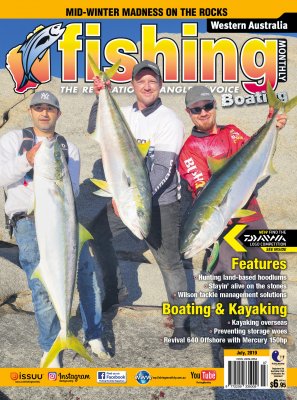Hunting hoodlums off the rocks by Jacob Crispe
 Hoodlum: someone who is never up to any good, one who indulges in a life of crime and violence; a hooligan, thug or gangster. Fact: Yellowtail kingfish can grow up to two meters long and can weigh up to 70kg.
Hoodlum: someone who is never up to any good, one who indulges in a life of crime and violence; a hooligan, thug or gangster. Fact: Yellowtail kingfish can grow up to two meters long and can weigh up to 70kg.
The yellowtail kingfish, or 'hoodlums' as they are often known, has a well-earned reputation of winning nine out of ten battles when hooked by even the most serious of land-based anglers. Not only does this fish have ultimate brute power for its size, it's also got to be one of the smartest fish in the ocean, as not long into any fight, a kingfish will find the closest bit of reef or structure and swim around it and quickly bust off the most experienced anglers. When targeting these yellow tailed gangsters, most anglers will run a line class of 80-100lb braid and use heavy mono leader line from 130-200lb and a near locked drag.
IDENTIFYING AREAS TO TARGET
Kingfish are a serious predator fish and are always on the move, often hunting in bays and coves where baitfish get trapped. Capes and headlands are the best areas to look for these bays and coves, as there is always a massive variation in water depths within a close proximity.
Depths of 10-25m have always been productive, however we have found the areas that have deeper parts with water over 20m in depth to be a lot more productive. Heavily reefed up areas hold a wide range of other fish species, which the larger solitary kings will often cruise past on the hunt for the weakest link.
BEST TIMES
Between April to August has always been the most productive times of year, and when the kings are in bigger numbers. The new moon combined with a high tide is always going to be a great time get out there on the search for Kings, however we do find that the first light and around mid-afternoon of any day to be great times to have a line in the water. Always keep an eye on the tide times, as any tide change can fire up activity that can get the kingies feeding.
WINDOWS OF OPPORTUNITY
Growing up a rock fisherman's son, I learnt from a young age two very important weather conditions we always needed for that perfect window of opportunity, and I still check that at least one of those two conditions are in my favour before heading out. Those two important things are swell height and direction, and the other is wind speed and direction.
Swell height and direction is always the most important. The reason is that if the swell is in your face (coming straight towards you) it could become very dangerous and can potentially be fatal if you are washed in. Ideally, the swell coming from behind you will make for very safe and calm waters. This can make your day a lot more visual, as it's easier to spot free swimming fish and can create sight casting opportunities.
The preferred wind conditions are light tail wind (coming from behind). The benefits of a tail wind (besides the comfort of no wind blowing in your face) means you can get a longer cast and you are also able to use a surface balloon and have it go straight out.